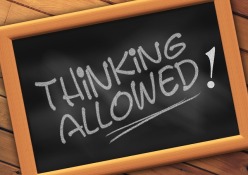“Are your students engaged?”
“Just find something that engages your students and do that.”
Phrases like this fly out of the mouths of well-meaning teachers, coaches, administrators, educators in this day and age all of the time. But what does it mean to “engage students”. Getting down on one knee and asking them, “Will you be engaged in class?” does not quite work out so well. So what does it look like when students are fully engrossed in, absorbed in, participating in, involved in, a.k.a. “engaged” in the learning process in a teacher’s classroom?
Here are some hints to help you identify when students are engaged in learning as well as teacher response or actions.

Eager Beavers
Students are raising their hands (or eagerly calling out) asking questions, adding comments, verbalizing observations about the instructional content being addressed in the lesson. Likewise, students are doing these same tasks through written communication, digitally, or in a visible way.
Teacher response: Get as many students involved in a whole-class discussion. If students are asking questions, say, “Okay, Jessica just mentioned this…raise your hand if you agree.” Then audibly count how many hands are raised. If a couple students have not raised their hands: “I noticed five of you did not raise your hands. John, why do you disagree with what Jessica said?” This affirms those students who have been participating and holds accountable those who either voted a different way or were not engaged. In essence, this teacher is saying, “There’s no hiding in my classroom! I know where you go to school!”

Team Talk and Discussion
Students are discussing content with their shoulder/face partner, teammates, classmates in such a way that the students in this group are listening, providing critical feedback to debate/agree with their partner. Students in the group are providing examples, scenarios, questions, and the like that all link back to the instructional content being addressed in the lesson/activity.
Teacher actions: Walk from group to group, table to table, listening in on students’ cooperative discussion. Ask a question of the group members that they may not have considered that could deepen their understanding. Then say, “Hmm…I’m going to go visit the other groups. But I’ll be circling back to your team because I’m really interested in what you all think about the question I gave.” Or “Hey everyone, this team has five examples of algebra uses in everyday life. Which team can find at least ten? Whichever team has the most examples written neatly on a sheet of paper wins a prize!” Then, step back and watch the fervor for learning spread!
Reflective Learning
Students are reflecting on what they are learning in cooperative groups, in notebooks, through a digital discussion post, in sticky notes to post at a designated part of the classroom. In some way they are saying to the class and teacher: “Hey, this is what I have learned and what I understand and I wanted to share this with you.”
Teacher actions: Read their comments. If this a digital posting like eCampus Discussion board or Padlet, project the student response so their classmates can view and contribute respectful responses. Add a reflective comment, example, probing question or helpful feedback of your own. This communicates to students that you are not a distant grading-observer, but you are genuinely involved in and curious about what they think and that you are a learner as well.

My Brain Hurts
Students may very well be saying, “This is making me think too much”, or they may be asking their teacher for the answer so that they don’t have to worry their brain cells. This can get tricky, but often times, they really mean, “I know what I am being asked to do. I can do it, however, the effort and energy I know I need to put into this is more than I feel like giving at this moment.”
Teacher response: This is not the time to let their minds off the hook, but is the perfect opportunity to provide a warm but demanding stance as a teacher. “I know you can do this, and it’s okay that this is a little challenging. This tells me that you are processing the information on a deeper and more powerful level. Keep going!” Or “Wait. You said yesterday that this made sense to you because of … How does yesterday’s lesson tie into this concept that you think is challenging? How does it connect or relate? What examples from yesterday’s notes can help you with what you are learning today?”
It’s Not Them, It’s You
Students are very possibly so engrossed in the content/activity etc. that the noise level in the classroom has increased. Most middle school students naturally process orally, out LOUD to each other and to their teachers. A quiet classroom does not always equal a learning classroom.
Teacher response: First, ask yourself “If I know my students are actively participating and engrossed with this lesson, why is the noise level bothering me?” Many teachers’ teachers in K-12 felt quiet meant better and so they carry this mantra throughout their teaching practice. However, this is not a good reason to quiet the class down. It is great to be mindful of the classes around you. (A quick phone call or conversation to your neighboring teachers “Are we too loud?” may be all you need to solve this dilemma. Most of the time, what is loud to you is a low noise to them. They are busy teaching so probably not even paying attention to any high level of learning 😉 happening in your classroom.) Another way to help bring down the noise while maintaining high engagement is to do a quick cooperative learning activity like All Write Round Robin in which students reflect, respond, give feedback- without talking- on one sheet of paper passed around their table like Round Robin. This helps to re-engage any off-task talking or behavior, is a great formative assessment, and gives a noise break that some students may need to re-focus on the main activity or task.
Last but not least: What Are “Engaging” Activities?

Some teachers think they have to do the entire song and dance to get their students interested in learning. While an electric slide or a Soul Train Line brain-break never hurt anyone (GoNoodle, anyone?), teachers should not feel as though they should be the entertainer in the classroom. Students will possibly laugh and listen one time with this strategy, but will soon lose respect for this teacher and end up not understanding or recalling any content that was taught. Most students, yes, even the too cool for school 8th graders, like a routine. Routines provide predictability, order, and security in the classroom. However, what some teachers miss are those quiet but meaningful cues students give off when they are not engaged, and sometimes it is because teachers are bound and determined to finish that lesson, that they have lost focus on the learners in the room.
 Take the Challenge
Take the Challenge
- During these lull moments, try adding a brain break or a cooperative learning strategy that gets students up and moving.
- Designate a team ambassador from each team to rotate around from group to group to share what they have learned so far in class. Give each student an opportunity to be the ambassador, while the students sitting at the table have the job of recording their what their peers have learned on a sheet of paper…like a moving Jigsaw. Collect the sheet for a formative assessment and tell students this is a class quiz.
- Change up an activity. If students are always at the same table, incorporate station rotation. If they are always using station rotation, have them sit at one table for a day and incorporate a fun team building activity.
- Add a digital component.
- Have class outside but tie in the surroundings into the lesson.
Engaging tasks and activities are endless, but it begins with reading our students and knowing them.
Having students so engrossed in learning that it becomes enjoyable work for them is ideal, however, this is not always easy to achieve. Students are in school primarily to learn. So understanding the practical ways engagement manifests itself in the learning environment are golden keys to help guide you and your students to deepen these enrichment opportunities from one unit to the next, from one day to the next and for the rest of the year. Engagement should not be a nebulous amorphous term that some teachers and classrooms simply have or lack because of the subject area or teacher personality. Just as all students can learn, all students can be engaged in learning.

Thank you, Regina for your efforts as a Teacher Leader at Milwee. This article merely touches on the quality of support you provide to our teachers AND students.
Well done!